Chūō Main Line
| Chūō Main Line | |||
|---|---|---|---|
| JB JC CF | |||
 | |||
| Overview | |||
| Native name | 中央本線 | ||
| Type |
Heavy rail, Passenger/Freight Rail Intercity rail, Regional rail, Commuter rail | ||
| Locale | Tokyo, Kanagawa, Yamanashi, Nagano, Gifu, Aichi prefectures | ||
| Termini |
Tokyo Nagoya | ||
| Stations | 112 | ||
| Operation | |||
| Opened | 1889 | ||
| Operator(s) | JR East, JR Central | ||
| Technical | |||
| Line length | 424.6 km (263.8 mi) | ||
| Track gauge | 1,067 mm (3 ft 6 in) | ||
| Electrification | 1,500 V DC Overhead lines | ||
| Operating speed | 130 km/h (80 mph) | ||
| |||
The Chūō Main Line (中央本線 Chūō-honsen), commonly called the Chūō Line, is one of the major trunk railway lines in Japan. It connects Tokyo and Nagoya, although it is the slowest direct railway connection between the two cities; the coastal Tōkaidō Main Line is slightly faster, and the Tōkaidō Shinkansen is the fastest rail link between the cities.
The eastern portion, the Chūō East Line (中央東線 Chūō-tōsen), is operated by the East Japan Railway Company (JR East), while the western portion, the Chūō West Line (中央西線 Chūō-saisen), is operated by the Central Japan Railway Company (JR Central). The dividing point between the two companies is Shiojiri Station, where express trains from both operators continue to the Shinonoi Line towards the cities of Matsumoto and Nagano. Compared to the huge urban areas at either end of the Chūō Line, its central portion is very lightly traveled; the Shiojiri-Nakatsugawa corridor is only served by twice-hourly local and hourly limited express trains.
The Chūō Main Line passes through the mountainous center of Honshu. Its highest point (near Fujimi Station) is about 900 meters above sea level and much of the line has a gradient of 25 per mil (2.5% or 1 in 40). Along the Chūō East Line section, peaks of the Akaishi and Kiso as well as Mount Yatsugatake can be seen from trains. The Chūō West Line parallels the old Nakasendō highway (famous for the preserved post towns of Tsumago-juku and Magome-juku) and the steep Kiso Valley.
Routes
- Entire Route (Tokyo - Nagoya including branch): 424.6 km
- East Line (Tokyo - Shiojiri): 222.1 km
- Tokyo - Kanda: 1.3 km (officially part of the Tōhoku Main Line)
- Kanda - Yoyogi: 8.3 km
- Yoyogi - Shinjuku: 0.7 km (officially part of the Yamanote Line)
- Shinjuku - Shiojiri: 211.8 km
- East Line - Tatsuno branch line (Okaya - Tatsuno - Shiojiri): 27.7 km
- West Line (Shiojiri - Nagoya): 174.8 km
- Shiojiri - Kanayama: 171.5 km
- Kanayama - Nagoya: 3.3 km (alongside Tōkaidō Main Line)
Stations and services
Chūō Main Line (East Line) | |||||||||||||||||||||||||||||||||||||||||||||||||||||||||||||||||||||||||||||||||||||||||||||||||||||||||||||||||||||||||||||||||||||||||||||||||||||||||||||||||||||||||||||||||||||||||||||||||||||||||||||||||||||||||||||||||||||||||||||||||||||||||||||||||||||||||||||||||||||||||||||||||||||||||||||||||||||||||||||||||||||||||||||||||||||||||||||||||||||||||||||||||||||||||||||||||||||||||||||||||||||||||||||||||||||||||||||||||||||||||||||||||||||||||||||||||||||||||||||||||||||||||||||||||||||||||||||||||||||||||||||||||||||||||||||||||||||||||||||||||||||||||||||||||||||||||||||||||||||||||||||||||||||||||||||||||||||||||||||||||||||||||||||||||||||||||||||||||||||||||||||||||||||||||||||||||||||||||||||||||||||||||||||||||||||||||||||||||||||||||||||||||||||||||||||||||||||||||||||||||||||||||||||||||||||||||||||||||||||||||||||||||||||||||||||||||||||||||||||||||||||||||||||||||||||||||||||||||||||||||||||||||||||||||||||||||||||||||||||||||||||||||||||||||||||||||||||||||||||||
|---|---|---|---|---|---|---|---|---|---|---|---|---|---|---|---|---|---|---|---|---|---|---|---|---|---|---|---|---|---|---|---|---|---|---|---|---|---|---|---|---|---|---|---|---|---|---|---|---|---|---|---|---|---|---|---|---|---|---|---|---|---|---|---|---|---|---|---|---|---|---|---|---|---|---|---|---|---|---|---|---|---|---|---|---|---|---|---|---|---|---|---|---|---|---|---|---|---|---|---|---|---|---|---|---|---|---|---|---|---|---|---|---|---|---|---|---|---|---|---|---|---|---|---|---|---|---|---|---|---|---|---|---|---|---|---|---|---|---|---|---|---|---|---|---|---|---|---|---|---|---|---|---|---|---|---|---|---|---|---|---|---|---|---|---|---|---|---|---|---|---|---|---|---|---|---|---|---|---|---|---|---|---|---|---|---|---|---|---|---|---|---|---|---|---|---|---|---|---|---|---|---|---|---|---|---|---|---|---|---|---|---|---|---|---|---|---|---|---|---|---|---|---|---|---|---|---|---|---|---|---|---|---|---|---|---|---|---|---|---|---|---|---|---|---|---|---|---|---|---|---|---|---|---|---|---|---|---|---|---|---|---|---|---|---|---|---|---|---|---|---|---|---|---|---|---|---|---|---|---|---|---|---|---|---|---|---|---|---|---|---|---|---|---|---|---|---|---|---|---|---|---|---|---|---|---|---|---|---|---|---|---|---|---|---|---|---|---|---|---|---|---|---|---|---|---|---|---|---|---|---|---|---|---|---|---|---|---|---|---|---|---|---|---|---|---|---|---|---|---|---|---|---|---|---|---|---|---|---|---|---|---|---|---|---|---|---|---|---|---|---|---|---|---|---|---|---|---|---|---|---|---|---|---|---|---|---|---|---|---|---|---|---|---|---|---|---|---|---|---|---|---|---|---|---|---|---|---|---|---|---|---|---|---|---|---|---|---|---|---|---|---|---|---|---|---|---|---|---|---|---|---|---|---|---|---|---|---|---|---|---|---|---|---|---|---|---|---|---|---|---|---|---|---|---|---|---|---|---|---|---|---|---|---|---|---|---|---|---|---|---|---|---|---|---|---|---|---|---|---|---|---|---|---|---|---|---|---|---|---|---|---|---|---|---|---|---|---|---|---|---|---|---|---|---|---|---|---|---|---|---|---|---|---|---|---|---|---|---|---|---|---|---|---|---|---|---|---|---|---|---|---|---|---|---|---|---|---|---|---|---|---|---|---|---|---|---|---|---|---|---|---|---|---|---|---|---|---|---|---|---|---|---|---|---|---|---|---|---|---|---|---|---|---|---|---|---|---|---|---|---|---|---|---|---|---|---|---|---|---|---|---|---|---|---|---|---|---|---|---|---|---|---|---|---|---|---|---|---|---|---|---|---|---|---|---|---|---|---|---|---|---|---|---|---|---|---|---|---|---|---|---|---|---|---|---|---|---|---|---|---|---|---|---|---|---|---|---|---|---|---|---|---|---|---|---|---|---|---|---|---|---|---|---|---|---|---|---|---|---|---|---|---|---|---|---|---|---|---|---|---|---|---|---|---|---|---|---|---|---|---|---|---|---|---|---|---|---|---|---|---|---|---|---|---|---|---|---|---|---|---|---|---|---|---|---|---|---|---|---|---|---|---|---|---|---|---|---|---|---|---|---|---|---|---|---|---|---|---|---|---|---|---|---|---|---|---|---|---|---|---|---|---|---|---|---|---|---|---|---|---|---|---|---|---|---|---|---|---|---|---|---|---|---|---|---|---|---|---|---|---|---|---|---|---|---|---|---|---|---|---|---|---|---|---|---|---|---|---|---|---|---|---|---|---|---|---|---|---|---|---|---|---|---|---|---|---|---|---|---|---|---|---|---|---|---|---|---|---|---|---|---|---|---|---|---|---|---|---|---|---|---|---|---|---|---|---|---|---|---|---|---|---|---|---|---|---|---|---|---|---|---|---|---|---|---|---|---|---|---|---|---|---|---|---|---|---|---|---|---|---|---|---|---|---|---|---|---|---|---|---|---|---|---|---|---|---|---|---|---|---|---|---|---|---|---|---|---|---|---|---|---|---|---|---|---|---|---|---|---|---|---|---|---|---|---|---|---|---|---|---|---|---|---|---|---|---|---|---|---|---|---|---|---|---|---|---|---|---|---|---|---|---|---|---|---|---|---|---|---|---|---|---|---|---|---|---|---|---|---|---|---|---|---|---|---|---|---|---|---|---|---|---|---|---|---|---|---|---|---|---|---|---|---|---|---|---|---|---|---|
| |||||||||||||||||||||||||||||||||||||||||||||||||||||||||||||||||||||||||||||||||||||||||||||||||||||||||||||||||||||||||||||||||||||||||||||||||||||||||||||||||||||||||||||||||||||||||||||||||||||||||||||||||||||||||||||||||||||||||||||||||||||||||||||||||||||||||||||||||||||||||||||||||||||||||||||||||||||||||||||||||||||||||||||||||||||||||||||||||||||||||||||||||||||||||||||||||||||||||||||||||||||||||||||||||||||||||||||||||||||||||||||||||||||||||||||||||||||||||||||||||||||||||||||||||||||||||||||||||||||||||||||||||||||||||||||||||||||||||||||||||||||||||||||||||||||||||||||||||||||||||||||||||||||||||||||||||||||||||||||||||||||||||||||||||||||||||||||||||||||||||||||||||||||||||||||||||||||||||||||||||||||||||||||||||||||||||||||||||||||||||||||||||||||||||||||||||||||||||||||||||||||||||||||||||||||||||||||||||||||||||||||||||||||||||||||||||||||||||||||||||||||||||||||||||||||||||||||||||||||||||||||||||||||||||||||||||||||||||||||||||||||||||||||||||||||||||||||||||||||||
This section lists all stations on the Chūō Main Line and generally explains regional services on the line. In addition, there are limited express services connecting major cities along the line, namely Azusa, Super Azusa, Kaiji, Hamakaiji, Narita Express and Shinano. For details of the limited express trains, see the relevant articles.
Tokyo - Mitaka

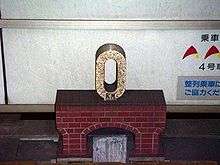
The section between Tokyo and Mitaka is grade-separated, with no level crossings. Between Ochanomizu and Mitaka, the Chūō Main Line has four tracks; two of them are local tracks (緩行線 kankō-sen) with platforms at every station; the other two are rapid tracks (快速線 kaisoku-sen) with some stations without platforms. The local tracks are used by the main line local trains (operated only in early morning and late night) and the Chūō-Sōbu Line local trains, while the rapid tracks carry rapid service and limited express trains. The Tokyo-Mitaka portion is a vital cross-city rail link.
The commuter services on the rapid tracks are collectively called the Chūō Line (Rapid) in comparison with the Chūō Line (Local) (中央線各駅停車 Chūō-sen-kakuekiteisha) or the Chūō-Sōbu Line on the local tracks. The former is usually referred to simply as the Chūō Line and the latter the Sōbu Line. Separate groups of trainsets are used for these two groups of services: cars with an orange belt for the rapid service trains and cars with a yellow belt for the local service trains, with the exception of early morning and late night local service trains which use cars with an orange belt. Signs at stations also use these colors to indicate the services.
This section is located entirely within Tokyo.
Legends for the table
- Local trains:
- S: Chūō-Sōbu Line local trains
- L: Local trains from/to Tokyo operating during early morning and late night hours using rapid train cars
- T: Local trains through to Tozai Line
- Rapid trains (Chūō Line (Rapid)):
- R: Rapid (快速 Kaisoku)
- CR: Commuter Rapid (通勤快速 Tsūkin Kaisoku)
- SR: Chūō Special Rapid (中央特快 Chūō Tokkai) / Ōme Special Rapid (青梅特快 Ōme Tokkai) through to Ōme Line
- CSR: Commuter Special Rapid (通勤特快 Tsūkin Tokkai)
- ●: All trains stop
- | : All trains pass
- ◆: All trains pass on weekends and national holidays
| No. | Station | Distance (km) |
Stops (See legend above) |
Transfers | Location | ||||||
|---|---|---|---|---|---|---|---|---|---|---|---|
| Local | Rapid | ||||||||||
| S | L | T | R | CR | SR | CSR | |||||
TYOJC01 |
Tokyo | 0.0 | ● | ● | ● | ● | ● | Chiyoda | |||
KNDJC02 |
Kanda | 1.3 | ● | ● | ● | ● | ● |
| |||
| JC03 JB18 | Ochanomizu | 2.6 | ● | ● | ● | ● | ● | ● | |||
| JB17 | Suidōbashi | 3.4 | ● | ● | | | | | | | | | Toei Mita Line | ||
| JB16 | Iidabashi | 3.4 | ● | ● | ●[Note 1] | | | | | | | | | ||
| JB15 | Ichigaya | 5.8 | ● | ● | | | | | | | | | |||
| JC04 JB14 | Yotsuya | 6.6 | ● | ● | ● | ● | ● | ● |
| ||
| JB13 | Shinanomachi | 7.9 | ● | ● | | | | | | | | | Shinjuku | ||
| JB12 | Sendagaya | 8.6 | ● | ● | | | | | | | | | Toei Oedo Line (at Kokuritsu-kyogijo) | Shibuya | |
| JB11 | Yoyogi | 9.6 | ● | ● | | | | | | | | |
| ||
| SJKJC05 JB10 | Shinjuku | 10.3 | ● | ● | ● | ● | ● | ● | Shinjuku | ||
| JB09 | Ōkubo | 11.7 | ● | ● | | | | | | | | | |||
| JB08 | Higashi-Nakano | 12.8 | ● | ● | | | | | | | | | Toei Oedo Line | Nakano | |
| JC06 JB07 | Nakano | 14.7 | ● | ● | ● | ● | ● | ● | | | Tokyo Metro Tozai Line (through service) | |
| JC07 JB06 | Kōenji | 16.1 | ● | ● | ● | ◆ | | | | | | | Suginami | |
| JC08 JB05 | Asagaya | 17.3 | ● | ● | ● | ◆ | | | | | | | ||
| JC09 JB04 | Ogikubo | 18.7 | ● | ● | ● | ● | ● | | | | | Tokyo Metro Marunouchi Line | |
| JC10 JB03 | Nishi-Ogikubo | 20.6 | ● | ● | ● | ◆ | | | | | | | ||
| JC11 JB02 | Kichijōji | 22.5 | ● | ● | ● | ● | ● | | | | | Keio Inokashira Line | Musashino |
| JC12 JB01 | Mitaka | 24.1 | ● | ● | ● | ● | ● | ● | | | Mitaka | |
Notes:
- ↑ Tozai Line through trains stop at the Tozai Line (Tokyo Metro) section of Iidabashi Station. They run on the Tozai Line instead of the Chūō Line east of Nakano.
Mitaka - Takao
The four-track section ends at Mitaka. Most of the section between Mitaka and Tachikawa had been elevated between 2008-2011 to eliminate level crossings. Plans have been proposed to add another two tracks as far as Tachikawa, but were not included in the track elevation.
This section is also entirely in Tokyo. For legends on train types, see the preceding section.
| No. | Station | Distance (km) |
Stops | Transfers | Location | |||||
|---|---|---|---|---|---|---|---|---|---|---|
| Local | Rapid | |||||||||
| S | L | R | CR | SR | CSR | |||||
| JC12 | Mitaka | 24.1 | ● | ● | ● | ● | ● | | | Mitaka | |
| JC13 | Musashi-Sakai | 25.7 | ● | ● | ● | | | | | | | Seibu Tamagawa Line | Musashino |
| JC14 | Higashi-Koganei | 27.4 | ● | ● | ● | | | | | | | Koganei | |
| JC15 | Musashi-Koganei | 29.1 | ● | ● | ● | | | | | | | ||
| JC16 | Kokubunji | 31.4 | ● | ● | ● | ● | ● | ● | Kokubunji | |
| JC17 | Nishi-Kokubunji | 32.8 | ● | ● | ● | | | | | | | JM Musashino Line | |
| JC18 | Kunitachi | 34.5 | ● | ● | ● | | | | | | | Kunitachi | |
| JC19 | Tachikawa | 37.5 | ● | ● | ● | ● | ● | ● |
|
Tachikawa |
| JC20 | Hino | 40.8 | ● | ● | ● | ● | | | Hino | ||
| JC21 | Toyoda | 43.1 | ● | ● | ● | ● | | | |||
| JC22 | Hachiōji | 47.4 | ● | ● | ● | ● | ● | Hachiōji | ||
| JC23 | Nishi-Hachiōji | 49.8 | ● | ● | ● | ● | | | |||
| JC24 | Takao | 53.1 | ● | ● | ● | ● | ● | Keiō Takao Line | ||
Takao - Shiojiri
Most of the rapid service trains from Tokyo terminate at Takao where the line exits the large urban area of Tokyo. The section between Takao and Ōtsuki still carries some commuter trains as well as long distance local trains and Limited Express trains. The Kaiji limited express terminates at Kōfu, the capital of Yamanashi Prefecture, while the Azusa and Super Azusa continue beyond Shiojiri to Matsumoto via the Shinonoi Line.
| Station | Distance | Transfers | Location | |
|---|---|---|---|---|
| Takao | 53.1 | Hachiōji | Tokyo | |
| Sagamiko | 62.6 | Sagamihara | Kanagawa | |
| Fujino | 66.3 | |||
| Uenohara | 69.8 | Uenohara | Yamanashi | |
| Shiotsu | 74.0 | |||
| Yanagawa | 77.6 | Ōtsuki | ||
| Torisawa | 81.2 | |||
| Saruhashi | 85.3 | |||
| Ōtsuki | 87.8 | Fujikyuko Line | ||
| Hatsukari | 93.9 | |||
| Sasago | 100.4 | |||
| Kai-Yamato | 106.5 | Kōshū | ||
| Katsunuma-budōkyō | 112.5 | |||
| Enzan | 116.9 | |||
| Higashi-Yamanashi | 120.1 | Yamanashi | ||
| Yamanashishi | 122.2 | |||
| Kasugaichō | 125.0 | Fuefuku | ||
| Isawa-onsen | 127.8 | |||
| Sakaori | 131.2 | Kōfu | ||
| Kōfu | 134.1 | Minobu Line | ||
| Ryūō | 138.6 | Kai | ||
| Shiozaki | 142.7 | |||
| Nirasaki | 147.0 | Nirasaki | ||
| Shimpu | 151.2 | |||
| Anayama | 154.7 | |||
| Hinoharu | 160.1 | Hokuto | ||
| Nagasaka | 166.3 | |||
| Kobuchizawa | 173.7 | Koumi Line | ||
| Shinano-Sakai | 178.2 | Fujimi | Nagano | |
| Fujimi | 182.9 | |||
| Suzurannosato | 186.1 | |||
| Aoyagi | 188.0 | Chino | ||
| Chino | 195.2 | |||
| Fumonji Junction | (198.9) | Suwa | ||
| Kami-Suwa | 201.9 | |||
| Shimo-Suwa | 206.3 | Shimosuwa | ||
| Okaya | 210.4 | Chūō Line (For Tatsuno) | Okaya | |
| Midoriko | 218.2 | Shiojiri | ||
| Shiojiri | 222.1 |
| ||
Okaya – Shiojiri
Okaya – Shiojiri Branch | |||||||||||||||||||||||||||||||||||||||||||||||||||||||||||||||||||||||||||||||||||||||||||||||||||||||||||||||||||||||||||||||||||||||||||||||||||||||||||||||||||||||||||||||||||||||||||||
|---|---|---|---|---|---|---|---|---|---|---|---|---|---|---|---|---|---|---|---|---|---|---|---|---|---|---|---|---|---|---|---|---|---|---|---|---|---|---|---|---|---|---|---|---|---|---|---|---|---|---|---|---|---|---|---|---|---|---|---|---|---|---|---|---|---|---|---|---|---|---|---|---|---|---|---|---|---|---|---|---|---|---|---|---|---|---|---|---|---|---|---|---|---|---|---|---|---|---|---|---|---|---|---|---|---|---|---|---|---|---|---|---|---|---|---|---|---|---|---|---|---|---|---|---|---|---|---|---|---|---|---|---|---|---|---|---|---|---|---|---|---|---|---|---|---|---|---|---|---|---|---|---|---|---|---|---|---|---|---|---|---|---|---|---|---|---|---|---|---|---|---|---|---|---|---|---|---|---|---|---|---|---|---|---|---|---|---|---|---|
| |||||||||||||||||||||||||||||||||||||||||||||||||||||||||||||||||||||||||||||||||||||||||||||||||||||||||||||||||||||||||||||||||||||||||||||||||||||||||||||||||||||||||||||||||||||||||||||
The Okaya-Shiojiri branch is an old route of the Chūō Main Line. It carries a small number of shuttle trains and trains from/to the Iida Line, which branches off at Tatsuno.
| Station | Distance | Transfers | Location | |
|---|---|---|---|---|
| Okaya | 210.4 | Chūō Line (for Kami-Suwa, Midoriko) | Okaya | Nagano |
| Kawagishi | 213.9 | |||
| Tatsuno | 219.9 | Iida Line | Tatsuno | |
| Shinano-Kawashima | 224.2 | |||
| Ono | 228.2 | |||
| Shiojiri | 238.1 |
|
Shiojiri | |
Prior to the opening of the new route between Okaya and Shiojiri, there was a junction (Higashi-Shiojiri Junction (東塩尻信号場)) between Ono and Shiojiri stations. It had a reversing layout. The signal station was closed on October 12, 1983.
Shiojiri - Nakatsugawa
Chūō Main Line (West Line) | |||||||||||||||||||||||||||||||||||||||||||||||||||||||||||||||||||||||||||||||||||||||||||||||||||||||||||||||||||||||||||||||||||||||||||||||||||||||||||||||||||||||||||||||||||||||||||||||||||||||||||||||||||||||||||||||||||||||||||||||||||||||||||||||||||||||||||||||||||||||||||||||||||||||||||||||||||||||||||||||||||||||||||||||||||||||||||||||||||||||||||||||||||||||||||||||||||||||||||||||||||||||||||||||||||||||||||||||||||||||||||||||||||||||||||||||||||||||||||||||||||||||||||||||||||||||||||||||||||||||||||||||||||||||||||||||||||||||||||||||||||||||||||||||||||||||||||||||||||||||||||||||||||||||||||||||||||||||||||||||||||||||||||||||||||||||||||||||||||||||||||||||||||||||||||||||||||||||||||||||||||||||||||||||||||||||||||||||||||||||||||||||||||||||||||||||||||||||||||||||||||||||||||||||||||||||||||||||||||||||||||||||||||||||||||||||||||||||||||||||||||||||||||||||||||||||||||||||||||||||||||||||||||||||||||||||||||||||||||||||||||||||||||||||||||||||||||||||||||||||
|---|---|---|---|---|---|---|---|---|---|---|---|---|---|---|---|---|---|---|---|---|---|---|---|---|---|---|---|---|---|---|---|---|---|---|---|---|---|---|---|---|---|---|---|---|---|---|---|---|---|---|---|---|---|---|---|---|---|---|---|---|---|---|---|---|---|---|---|---|---|---|---|---|---|---|---|---|---|---|---|---|---|---|---|---|---|---|---|---|---|---|---|---|---|---|---|---|---|---|---|---|---|---|---|---|---|---|---|---|---|---|---|---|---|---|---|---|---|---|---|---|---|---|---|---|---|---|---|---|---|---|---|---|---|---|---|---|---|---|---|---|---|---|---|---|---|---|---|---|---|---|---|---|---|---|---|---|---|---|---|---|---|---|---|---|---|---|---|---|---|---|---|---|---|---|---|---|---|---|---|---|---|---|---|---|---|---|---|---|---|---|---|---|---|---|---|---|---|---|---|---|---|---|---|---|---|---|---|---|---|---|---|---|---|---|---|---|---|---|---|---|---|---|---|---|---|---|---|---|---|---|---|---|---|---|---|---|---|---|---|---|---|---|---|---|---|---|---|---|---|---|---|---|---|---|---|---|---|---|---|---|---|---|---|---|---|---|---|---|---|---|---|---|---|---|---|---|---|---|---|---|---|---|---|---|---|---|---|---|---|---|---|---|---|---|---|---|---|---|---|---|---|---|---|---|---|---|---|---|---|---|---|---|---|---|---|---|---|---|---|---|---|---|---|---|---|---|---|---|---|---|---|---|---|---|---|---|---|---|---|---|---|---|---|---|---|---|---|---|---|---|---|---|---|---|---|---|---|---|---|---|---|---|---|---|---|---|---|---|---|---|---|---|---|---|---|---|---|---|---|---|---|---|---|---|---|---|---|---|---|---|---|---|---|---|---|---|---|---|---|---|---|---|---|---|---|---|---|---|---|---|---|---|---|---|---|---|---|---|---|---|---|---|---|---|---|---|---|---|---|---|---|---|---|---|---|---|---|---|---|---|---|---|---|---|---|---|---|---|---|---|---|---|---|---|---|---|---|---|---|---|---|---|---|---|---|---|---|---|---|---|---|---|---|---|---|---|---|---|---|---|---|---|---|---|---|---|---|---|---|---|---|---|---|---|---|---|---|---|---|---|---|---|---|---|---|---|---|---|---|---|---|---|---|---|---|---|---|---|---|---|---|---|---|---|---|---|---|---|---|---|---|---|---|---|---|---|---|---|---|---|---|---|---|---|---|---|---|---|---|---|---|---|---|---|---|---|---|---|---|---|---|---|---|---|---|---|---|---|---|---|---|---|---|---|---|---|---|---|---|---|---|---|---|---|---|---|---|---|---|---|---|---|---|---|---|---|---|---|---|---|---|---|---|---|---|---|---|---|---|---|---|---|---|---|---|---|---|---|---|---|---|---|---|---|---|---|---|---|---|---|---|---|---|---|---|---|---|---|---|---|---|---|---|---|---|---|---|---|---|---|---|---|---|---|---|---|---|---|---|---|---|---|---|---|---|---|---|---|---|---|---|---|---|---|---|---|---|---|---|---|---|---|---|---|---|---|---|---|---|---|---|---|---|---|---|---|---|---|---|---|---|---|---|---|---|---|---|---|---|---|---|---|---|---|---|---|---|---|---|---|---|---|---|---|---|---|---|---|---|---|---|---|---|---|---|---|---|---|---|---|---|---|---|---|---|---|---|---|---|---|---|---|---|---|---|---|---|---|---|---|---|---|---|---|---|---|---|---|---|---|---|---|---|---|---|---|---|---|---|---|---|---|---|---|---|---|---|---|---|---|---|---|---|---|---|---|---|---|---|---|---|---|---|---|---|---|---|---|---|---|---|---|---|---|---|---|---|---|---|---|---|---|---|---|---|---|---|---|---|---|---|---|---|---|---|---|---|---|---|---|---|---|---|---|---|---|---|---|---|---|---|---|---|---|---|---|---|---|---|---|---|---|---|---|---|---|---|---|---|---|---|---|---|---|---|---|---|---|---|---|---|---|---|---|---|---|---|---|---|---|---|---|---|---|---|---|---|---|---|---|---|---|---|---|---|---|---|---|---|---|---|---|---|---|---|---|---|---|---|---|---|---|---|---|---|---|---|---|---|---|---|---|---|---|---|---|---|---|---|---|---|---|---|---|---|---|---|---|---|---|---|---|---|---|---|---|---|---|---|---|---|---|---|---|---|---|---|---|---|---|---|---|---|---|---|---|---|---|---|---|---|---|---|---|---|---|---|---|---|---|---|---|---|---|---|---|---|---|---|
| |||||||||||||||||||||||||||||||||||||||||||||||||||||||||||||||||||||||||||||||||||||||||||||||||||||||||||||||||||||||||||||||||||||||||||||||||||||||||||||||||||||||||||||||||||||||||||||||||||||||||||||||||||||||||||||||||||||||||||||||||||||||||||||||||||||||||||||||||||||||||||||||||||||||||||||||||||||||||||||||||||||||||||||||||||||||||||||||||||||||||||||||||||||||||||||||||||||||||||||||||||||||||||||||||||||||||||||||||||||||||||||||||||||||||||||||||||||||||||||||||||||||||||||||||||||||||||||||||||||||||||||||||||||||||||||||||||||||||||||||||||||||||||||||||||||||||||||||||||||||||||||||||||||||||||||||||||||||||||||||||||||||||||||||||||||||||||||||||||||||||||||||||||||||||||||||||||||||||||||||||||||||||||||||||||||||||||||||||||||||||||||||||||||||||||||||||||||||||||||||||||||||||||||||||||||||||||||||||||||||||||||||||||||||||||||||||||||||||||||||||||||||||||||||||||||||||||||||||||||||||||||||||||||||||||||||||||||||||||||||||||||||||||||||||||||||||||||||||||||||
Shiojiri is the dividing point of the East Line and the West Line; no train continues from one to the other. The Shinano limited express is the main service for the rural Shiojiri-Nakatsugawa section.
| No. | Station | Distance | Transfers | Location | |
|---|---|---|---|---|---|
| Shiojiri | 222.1 | (see above) | Shiojiri | Nagano | |
| Seba | 226.3 | ||||
| Hideshio | 231.0 | ||||
| Niekawa | 236.2 | ||||
| Kiso-Hirasawa | 241.4 | ||||
| Narai | 243.2 | ||||
| Yabuhara | 249.8 | Kiso (village) | |||
| Miyanokoshi | 255.5 | Kiso (town) | |||
| Harano | 258.3 | ||||
| CF30 | Kiso-Fukushima | 263.8 | |||
| CF29 | Agematsu | 271.1 | Agematsu | ||
| Kuramoto | 277.7 | ||||
| Suhara | 282.5 | Ōkuwa | |||
| Ōkuwa | 285.8 | ||||
| Nojiri | 288.8 | ||||
| Jūnikane | 292.5 | Nagiso | |||
| CF23 | Nagiso | 298.0 | |||
| Tadachi | 304.3 | ||||
| Sakashita | 307.1 | Nakatsugawa | Gifu | ||
| Ochiaigawa | 313.2 | ||||
| CF19 | Nakatsugawa | 317.0 | Chūō Line (for Tajimi, Nagoya) | ||
Nakatsugawa - Nagoya
Local and rapid service trains run on the line from Nakatsugawa to Nagoya. This section carries urban traffic for the Greater Nagoya Area.
Legends:
- R: Rapid
- CL: Central Liner
- HL: Home Liner (Only some Home Liner trains stop at stations marked with an asterisk.)
| No. | Station | Distance (km) |
Stops | Transfers | Location | |||
|---|---|---|---|---|---|---|---|---|
| CF19 | Nakatsugawa | 317.0 | R | CL | HL | Nakatsugawa | Gifu | |
| CF18 | Mino-Sakamoto | 323.4 | R | CL | | | |||
| CF17 | Ena | 328.6 | R | CL | HL | Akechi Railroad Akechi Line | Ena | |
| CF16 | Takenami | 334.0 | R | CL | | | |||
| CF15 | Kamado | 339.4 | R | CL | | | Mizunami | ||
| CF14 | Mizunami | 346.8 | R | CL | HL | |||
| CF13 | Tokishi | 353.7 | R | CL | HL | Toki | ||
| CF12 | Tajimi | 360.7 | R | CL | HL | Taita Line | Tajimi | |
| CF11 | Kokokei | 365.3 | | | | | | | |||
| CF10 | Jōkōji | 368.8 | | | | | | | Kasugai | Aichi | |
| CF09 | Kōzōji | 372.9 | R | CL | HL* | Aichi Loop Line | ||
| CF08 | Jinryō | 376.1 | | | | | | | |||
| CF07 | Kasugai | 378.8 | R | | | | | |||
| CF06 | Kachigawa | 381.9 | R | | | | | Tōkai Transport Service Jōhoku Line | ||
| CF05 | Shin-Moriyama | 384.6 | | | | | | | Nagoya | ||
| CF04 | Ōzone | 387.1 | R | | | HL* | |||
| CF03 | Chikusa | 389.8 | R | CL | HL | ■Higashiyama Line | ||
| CF02 | Tsurumai | 391.3 | R | | | HL* | ■Tsurumai Line | ||
| CF01 | Kanayama | 393.6 | R | CL | HL | |||
| Sannō Junction | 395.1 | JR Freight Nagoyaminato Branch | ||||||
| CF00 | Nagoya | 396.9 | R | CL | HL | |||
Signals and junctions
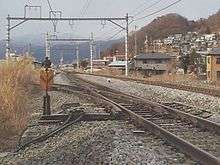
- Fumonji Junction (普門寺信号場 Fumonji Shingōjō) is a junction between Chino and Kami-Suwa stations in Suwa, Nagano. It entered into use on 2 September 1970.
- Sannō Junction (山王信号場 Sannō Shingōjō) is a junction that diverts freight traffic from the Chūō Main Line to the Tōkaidō Line freight branch between Kanayama and Nagoya stations in Nagoya. It entered into use on 10 October 1962.
Rolling stock
Chūō East Line (JR East)
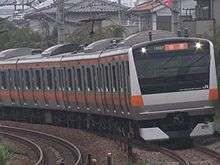
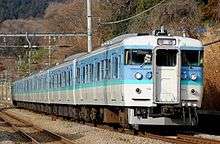
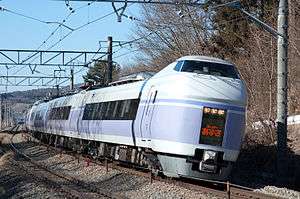
New E233 series trains entered service on Tokyo-area commuter services from 26 December 2006. These trains are a development of the E231 series used on other commuter lines in the Tokyo area, and replaced the aging 201 series rolling stock introduced on the line in 1981.
From 2016, new E353 series EMUs are scheduled to be introduced on Azusa and Super Azusa limited express services, replacing the E351 and E257 series trains.[1]
- Chūō Rapid Line
- Chūō-Sōbu Line
- Tokyo Metro Tōzai Line
- Local trains
- Limited Express
- E257 series (Azusa, Kaiji, Chūō Liner, Ōme Liner)
- E353 series (Super Azusa)
- E259 series (Narita Express) (One train per day starts/terminates at Takao)
- Seasonal services
- 183 series (Azusa, Wing Azusa, Moonlight Shinshū)
- 185 series (Hamakaiji)
- 215 series (View Yamanashi)
Chūō West Line (JR Central)
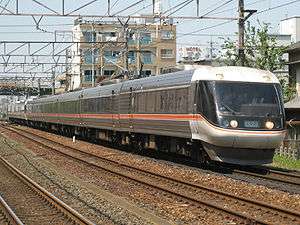
- Local Trains
- Limited Express
Freight train
History
The Kobu Railway (甲武鉄道) opened the initial section of the Chūō Line from Shinjuku Station to Tachikawa Station in 1889.[2] The company then extended the line both westward and eastward (towards Tokyo) until it was nationalised in 1906. The Japanese Government Railways (JGR) then continued to extend the line, reaching Shiojiri the same year, and Tokyo (at Shōheibashi Station (昌平橋駅)) in 1908. The JGR also built the line from Nagoya, the first section opening in 1900, with the lines connecting in 1911. The Table below gives the section opening dates.
In 1904, the section between Iidamachi Station (formerly located between Suidōbashi Station and Iidabashi Station) and Nakano Station was the first urban electric railway in Japan using 600 V DC. Electrification was extended in 1919 and 1922, was increased to 1,200 V DC when extended to Tokyo in 1927, boosted again to 1,500 V DC in 1929, and reached Kofu in 1931. Electrification from the Nagano end was commissioned in sections from 1966, and the entire line was electrified by 1973.
| Section | Opening date | Builder | |
|---|---|---|---|
| East Line | Tokyo | 1 March 1919[3] | JGR |
| Manseibashi † | |||
| 1 April 1912[3] | |||
| Shōheibashi † | |||
| 19 April 1908 | |||
| Ochanomizu | |||
| 31 December 1904 | Kōbu | ||
| Iidamachi † | |||
| 3 April 1895 | |||
| Ushigome † | |||
| 9 October 1894 | |||
| Shinjuku | |||
| 11 April 1889 | |||
| Tachikawa | |||
| 11 August 1889 | |||
| Hachiōji | |||
| 1 August 1901 | JGR | ||
| Uenohara | |||
| 1 June 1902 | |||
| Torisawa | |||
| 1 October 1902 | |||
| Ōtsuki | |||
| 1 February 1903 | |||
| Kai-Yamato (Hajikano) | |||
| 11 June 1903 | |||
| Kōfu | |||
| 15 December 1903 | |||
| Nirasaki | |||
| 21 December 1904 | |||
| Fujimi | |||
| 25 November 1905 | |||
| Okaya | |||
| 5 July 1983[3] (See note below) |
JNR | ||
| Shiojiri | |||
| West Line | 1 December 1909 | JGR | |
| Yabuhara | |||
| 5 October 1910 | |||
| Miyanokoshi | |||
| 1 May 1911 | |||
| Kiso-Fukushima | |||
| 25 November 1910 | |||
| Agematsu | |||
| 5 October 1910 | |||
| Suhara | |||
| 1 December 1909 | |||
| Nojiri | |||
| 1 September 1909 | |||
| Nagiso (Midono) | |||
| 15 July 1909 | |||
| Sakashita | |||
| 1 August 1908 | |||
| Nakatsugawa (Nakatsu) | |||
| 21 December 1902 | |||
| Tajimi | |||
| 25 July 1900 | |||
| Nagoya | |||
Notes:
- The section between Okaya Station and Shiojiri Station is the new route that replaced the old route opened on June 11, 1906 by JGR.
- Station names in parentheses are original names.
- Stations marked † are now closed.
- Prior to the connection of the East Line and the West Line in 1911, the section between Shiojiri Station and Miyanokoshi Station belonged to the East Line.
Former connecting lines
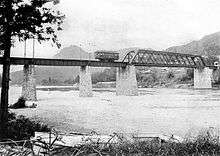
- Mitaka Station: A 3 km line to a Nakajima Aircraft factory opened in 1942, and was out of service in 1945. In 1950, the factory site was used to build a sports stadium. The line from Mitaka to Musashino Stadium (武蔵野競技場前) opened on 14 April 1951, but was closed from 1 November 1959.[3]
- Kokubunji Station: A 7 km line was opened in 1910 to haul gravel from the Tamagawa. It closed in 1914 due to flood damage, but was reopened in 1916 after being rebuilt by the Japanese Army. On 26 May 1920, the line was absorbed into JNR, but operations were suspended from 1 December 1921.[3] A 6 km extension to the Tokyo Racecourse opened on 1934.[3] Services on the line were suspended from 1 October 1944, resuming from 24 April 1947.[3] On 1 April 1973, the line to Tokyo Racecourse closed, and the freight line was absorbed into the Musashino Line.[3]
- Kofu Station: The Yamanashi horse-drawn tramway opened its first 660 mm (2 ft 2 in) gauge section in 1898, and by 1904 had opened two lines (to Katsunuma and Fujikawa) totaling 34 km. In 1930, the Katsunuma Line was closed, and the other line was closed beyond Kai-Aoyagi, 20 km from Kofu. The company renamed itself the Yamanashi Electric Railway, regauged (to 1,067 mm) and electrified the line at 600 V DC, and operated it until 1962.
- Sakashita Station: The 11 km 762 mm (2 ft 6 in) gauge Sakagawa Line was opened to Maruno by the Hisaka River Railway in 1926. A passenger service was operated 8 km to Okuya. The Forest Service opened a 9 km line connecting at Maruno the same year, and a 2 km branch from Okuya that operated from 1933 until 1958. In 1944, the Forest Service took over the Sakagawa line, operating it until 1961, when the entire 20 km line closed.
- Nakatsugawa Station: The Kitaena Railway operated the 23 km Enaden Line to Tsukechi, electrified at 600 V DC, from 1924 until 1978. At Tsukechi, it transshipped timber from a 762 mm (2 ft 6 in) gauge forest railway with an 18 km "main line" and a 14 km and two 5 km branch lines operated from 1932 until 1959.
- Ena Station: The Iwamura Electric Railway operated a 13 km line electrified at 600 V DC to its namesake town between 1906 and 1935. A 4 km line to the site of Oi dam was opened in 1922 to transport construction materials. Upon the dam's completion, the line was sold to the Kita-Ena Railway. but it closed in 1934.
- Tokishi Station: The Ogawa Railway opened a 10 km line to its namesake town between 1922 and 1924. The line was electrified at 1,500 V DC in 1950, and closed as a result of flood damage in 1972.
- Tajima Station: The Kasahara Railway opened a 5 km line to its namesake town in 1928. Passenger services ceased in 1971, and the line closed in 1978.
Proposed connecting lines
- Chino Station: The Saku Railway, which had built the line from Komoro on the Shinetsu Line to Koumi, proposed to build a line from Tanaka on the Shinetsu Line to this station. The company was nationalised before construction started, and JGR connected the Koumi line to the Chuo Main Line in 1935, making this proposal redundant.
Accidents
On September 12, 1997, a Super Azusa limited express bound for Matsumoto collided with a 201 series local train that failed to stop at a red signal while passing through Ōtsuki Station.
References
This article incorporates material from the corresponding article in the Japanese Wikipedia.
- ↑ JR東日本 富士山観光見込み、中央線特急に新型車両 [JR East to introduce new trains on Chuo Line limited express services, eying Mt Fuji tourism]. Sponichi Annex (in Japanese). Japan: Sports Nippon Newspapers. 16 September 2013. Retrieved 16 September 2013.
- ↑ http://www.jreast.co.jp/e/press/20070702/
- 1 2 3 4 5 6 7 8 Ishino, Tetsu, ed. (1998). 停車場変遷大辞典 国鉄・JR編 [Station Transition Directory - JNR/JR]. I. Japan: JTB. pp. 93–94. ISBN 4-533-02980-9.

.svg.png)
.svg.png)